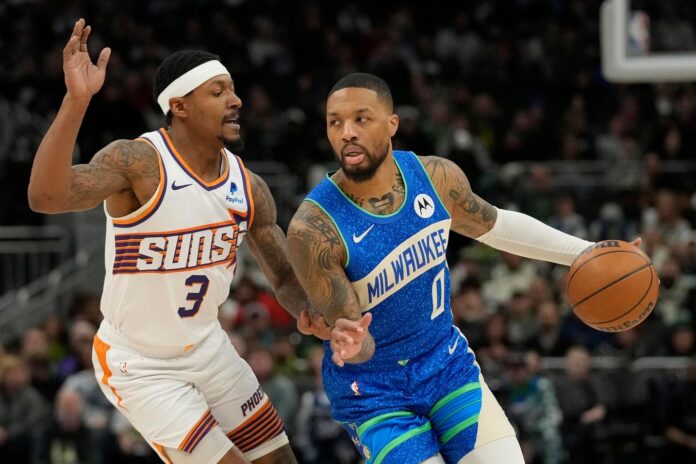MILWAUKEE, WISCONSIN – MARCH 17: Damian Lillard #0 of the Milwaukee Bucks dribbles the ball against … More
The Milwaukee Bucks and Phoenix Suns both traded a short-term problem for a longer-term headache this offseason.
With star forward Giannis Antetokounmpo “open-minded about exploring” his options, according to ESPN’s Shams Charania, the Bucks seemingly felt pressure to make a big splash to stave off a trade request. That convinced them to waive nine-time All-Star point guard Damian Lillard, who suffered a torn Achilles tendon in the first round of the playoffs in April, and stretch the remaining $112.6 million of his contract, leaving them with roughly a $22.5 million dead cap hit over each of the next five seasons.
The Suns followed suit shortly thereafter with Bradley Beal, whom they desperately tried to move ahead of the trade deadline to no avail. Beal still had two years and $110.8 million remaining on his contract at that point, and his no-trade clause gave him the power to scuttle any deal involving him, which might have been a deal-breaker for potentially interested suitors. Once the trade market proved similarly cold this offseason, the Suns bit the bullet and bought Beal out.
Unlike with Lillard, who is still set to collect the remainder of his contract from the Bucks, the Suns’ situation with Beal wasn’t as straightforward. Teams can have no more than 15% of the NBA’s annual salary cap tied up in dead cap hits from contract stretches, and the Suns already stretched Nassir Little ($3.1 million) and E.J. Liddell ($700,000). Had they outright waived Beal, he would have pushed them past the 15% threshold, so he had to give back nearly $14 million in his buyout.
Beal is signing a two-year, $11 million deal with the Los Angeles Clippers, so the Suns will get to deduct a small portion of what they owe him over the next two seasons. The same will go for the Bucks whenever Lillard signs with a new team. However, both the Suns and Bucks are otherwise saddled with massive dead cap hits through the remainder of the decade. In essence, both teams traded short-term relief for longer-term pain.
Stretching Lillard and Beal will help the Bucks and Suns this coming season. It just might wind up backfiring in the long haul, particularly as they try to get their respective superstars to stay put.
All-In On Giannis
The Bucks waived Lillard to carve out enough salary-cap space to sign former Indiana Pacers center Myles Turner to a four-year, $107 million contract. He’ll help make up for the loss of former starting center Brook Lopez, who signed a two-year, $18 million deal with the Los Angeles Clippers in free agency. The Bucks otherwise largely spent the offseason re-signing their own free agents, including Bobby Portis, Gary Trent Jr. and Kevin Porter Jr.
With 15 players on standard contracts, the Bucks are currently $16.1 million below the luxury-tax line and nearly $21.8 million below the first apron. They split their $8.8 million room mid-level exception between Kevin Porter Jr. ($5.1 million) and Gary Trent Jr. ($3.65 million), so they can’t make any more big free-agent splashes outside of a sign-and-trade.
The Bucks have been over the luxury-tax threshold in each of the past five seasons, but they figure to stay below it this year. If they do so, they’d move one step closer to resetting the clock on the repeater tax, which became even more punitive beginning in 2025-26. As long as they don’t pay the tax in one of the ensuing three seasons as well, they’d no longer be subject to the repeater rates until they were over the tax line at least three times in a four-year span.
That’s the good news. The bad news is that they now have a $22.5 million dead cap hit on their books for each of the next five seasons that they’ll have to navigate as they retool around Antetokounmpo.
The NBA’s salary cap is projected to continue rising fairly rapidly thanks to the league’s new national TV deals, which should help blunt the Bucks’ pain moving forward. Lillard’s dead cap hit is taking up nearly 14.6% of their overall cap space this year, but it’s currently projected to drop down to 13.6% in 2026-27 and 12.4% in 2027-28.
However, they’re still paying someone roughly $22.5 million per year over the next half-decade not to play basketball for them. In essence, they’ve built themselves a handicap that they’ll continually have to overcome throughout the remainder of Antetokounmpo’s prime.
Teams are already finding it difficult to build around two or three players on max contracts, particularly of the 35%-of-the-cap variety. The NBA’s new collective bargaining agreement is forcing teams into difficult financial choices, as evidenced by the Boston Celtics taking a stick of dynamite to their roster this offseason despite being only one year removed from winning a championship. And they weren’t saddled with an eight-figure dead cap hit, either.
In essence, Turner is the Bucks’ second max player between the salary he’s earning and Lillard’s dead cap hit. That will leave them with limited flexibility to add another star down the line unless they move on from him, as Big Threes are becoming endangered species in the modern NBA.
Team president Jon Horst told Eric Nehm of The Athletic that waiving Lillard and signing Turner was “really a now-versus-future decision,” as he felt responsible for “maximizing Giannis’ prime, our opportunities to win.” Adding Turner should make the Bucks better this coming season than the injured Lillard would have, but Lillard’s dead cap hit could hamper their stated desire to maximize their opportunities to win moving forward.
Suns’ Big Three Goes Boom
The Suns’ calculation with Beal was somewhat different than the Bucks’ with Lillard. Their star, Devin Booker, is not a flight risk whatsoever. In fact, he just signed a two-year, $145 million extension to ensure he’d be under contract through at least 2028-29.
So, why did the Suns buy Beal out rather than just take their medicine over the next two years? For one, he gave back nearly $14 million, which gives them the ability to waive and stretch his contract. While they haven’t officially done it yet, multiple sources told Gerald Bourguet of PHNX Sports that they’re “99 percent” likely to go that route.
As ESPN’s Shams Charania noted, stretching Beal’s contract would push the Suns under both the first and second apron, giving them access to a portion of the $14.1 million non-taxpayer mid-level exception. They’d also be free from the team-building restrictions that they’ve been stuck under for the past year, including the inability to aggregate contracts in trades.
The Suns are reinventing themselves as a younger, deeper, more athletic team in the wake of their Big Three’s implosion. But if they do stretch Beal, they’ll be left to grapple with his $19.4 million dead cap hit on their books for each of the next five years. That could hamper their ability to construct a championship contender around Booker, who’s now set to earn roughly 35% of the salary cap for the remainder of the decade.
This year alone, the Suns will be paying a combined $72.5 million for Booker and Beal, which is nearly 47% of the $154.7 million salary cap. That figure will drop slightly in future years since Beal’s dead cap hit will remain flat rather than increasing, but they’re still projected to be spending upward of 45% of the cap each year on those two players alone.
The Suns already have $154.7 million in salary on their books for the 2026-27 season, and that isn’t counting Mark Williams, whom they acquired in a draft-night trade. If they re-sign him, they’ll likely go soaring back over the salary cap, leaving them with limited avenues to improve their roster via free agency. They could have far more financial flexibility in 2027 if Jalen Green ($36.0 million) and Grayson Allen ($19.4 million) decline their respective player options, but that’d leave them rebuilding their roster from the ground up.
Perhaps young players such as Ryan Dunn, Oso Ighodaro, Khaman Maluach, Rasheer Fleming and Koby Brea will prove to be draft-day steals and give the Suns a solid young foundation around Booker. That’s their best hope at this point. Because otherwise, they’re still nearly out of draft picks over the next seven years.
It’s possible that the Bucks and Suns will manage to dig their way out of their self-created messes and build championship contenders around Antetokounmpo and Booker again. They’ve just increased the difficulty of doing so by handicapping themselves with NBA-record dead cap hits for the remainder of the decade.
Unless otherwise noted, all stats via NBA.com, PBPStats, Cleaning the Glass or Basketball Reference. All salary information via Spotrac and salary-cap information via RealGM. All odds via FanDuel Sportsbook.
Follow Bryan on Bluesky.



